IT in Criminal Justice: Analyzing Digital Crime Theories and Impacts
VerifiedAdded on 2020/03/07
|5
|1035
|150
Report
AI Summary
This report provides an overview of digital crime, also known as cybercrime, electronic crime, and computer crime, and explores its increasing prevalence. It examines various theories used to explain digital crime, including social learning theory, routine activity theory, and space transition theory. The report discusses how these theories help in understanding the causes of digital crime and how they can be used to prevent it. Additionally, it touches upon the rational choice theory. The report emphasizes the importance of awareness and support for the government in preventing digital crimes. It also highlights practical steps like securing computers and backing up information to protect against digital threats. The report concludes by emphasizing the importance of awareness and support for the government in preventing digital crimes.
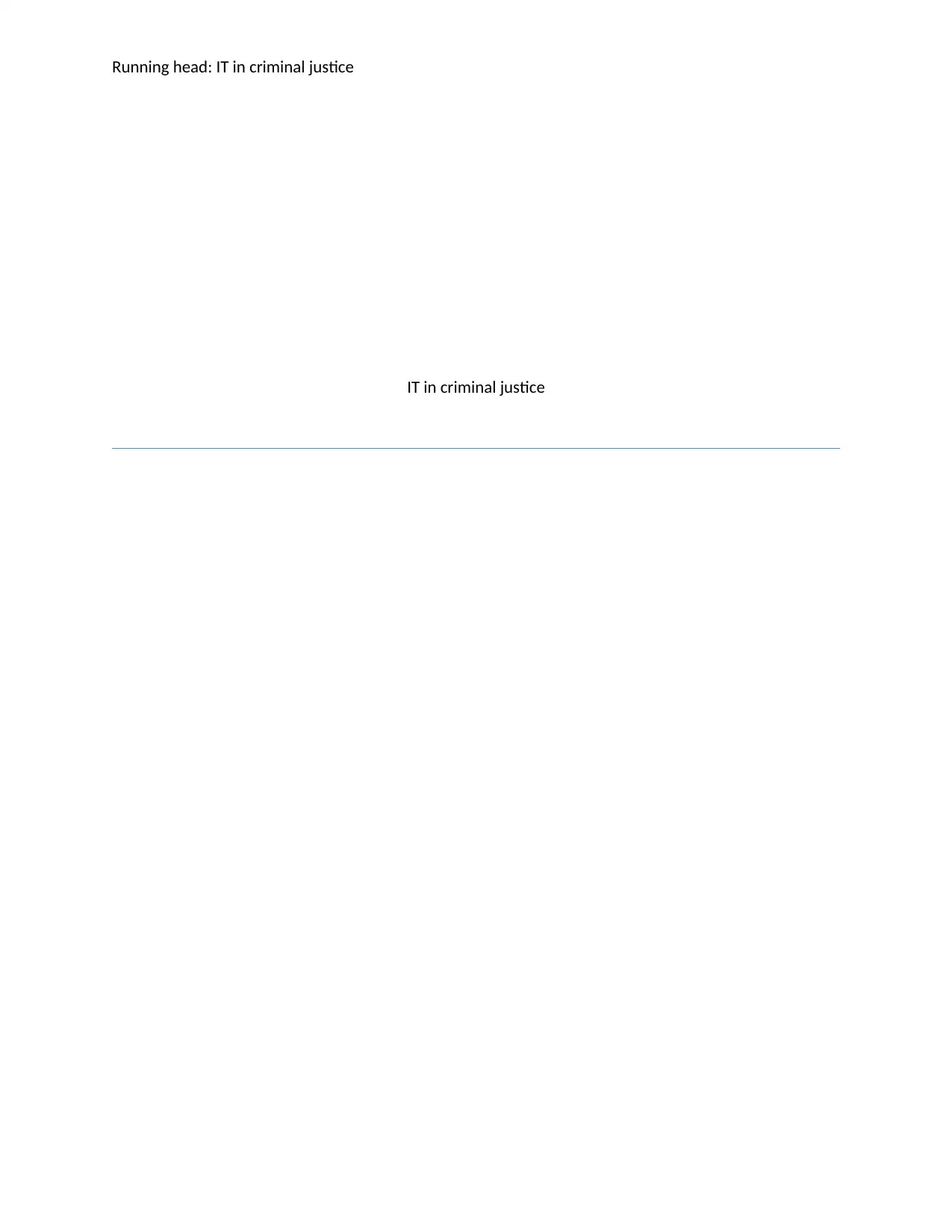
Running head: IT in criminal justice
IT in criminal justice
IT in criminal justice
Paraphrase This Document
Need a fresh take? Get an instant paraphrase of this document with our AI Paraphraser
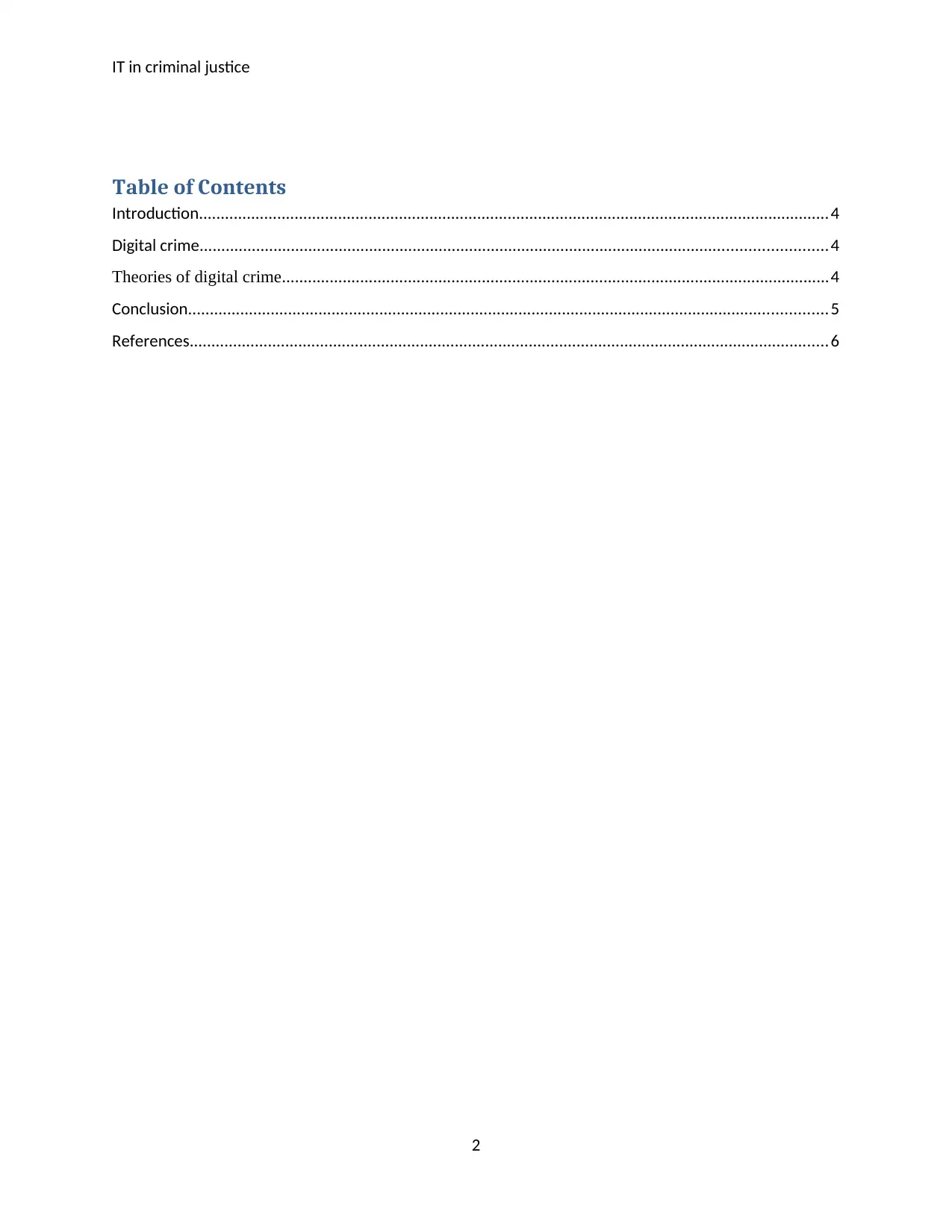
IT in criminal justice
Table of Contents
Introduction.................................................................................................................................................4
Digital crime................................................................................................................................................4
Theories of digital crime..............................................................................................................................4
Conclusion...................................................................................................................................................5
References...................................................................................................................................................6
2
Table of Contents
Introduction.................................................................................................................................................4
Digital crime................................................................................................................................................4
Theories of digital crime..............................................................................................................................4
Conclusion...................................................................................................................................................5
References...................................................................................................................................................6
2
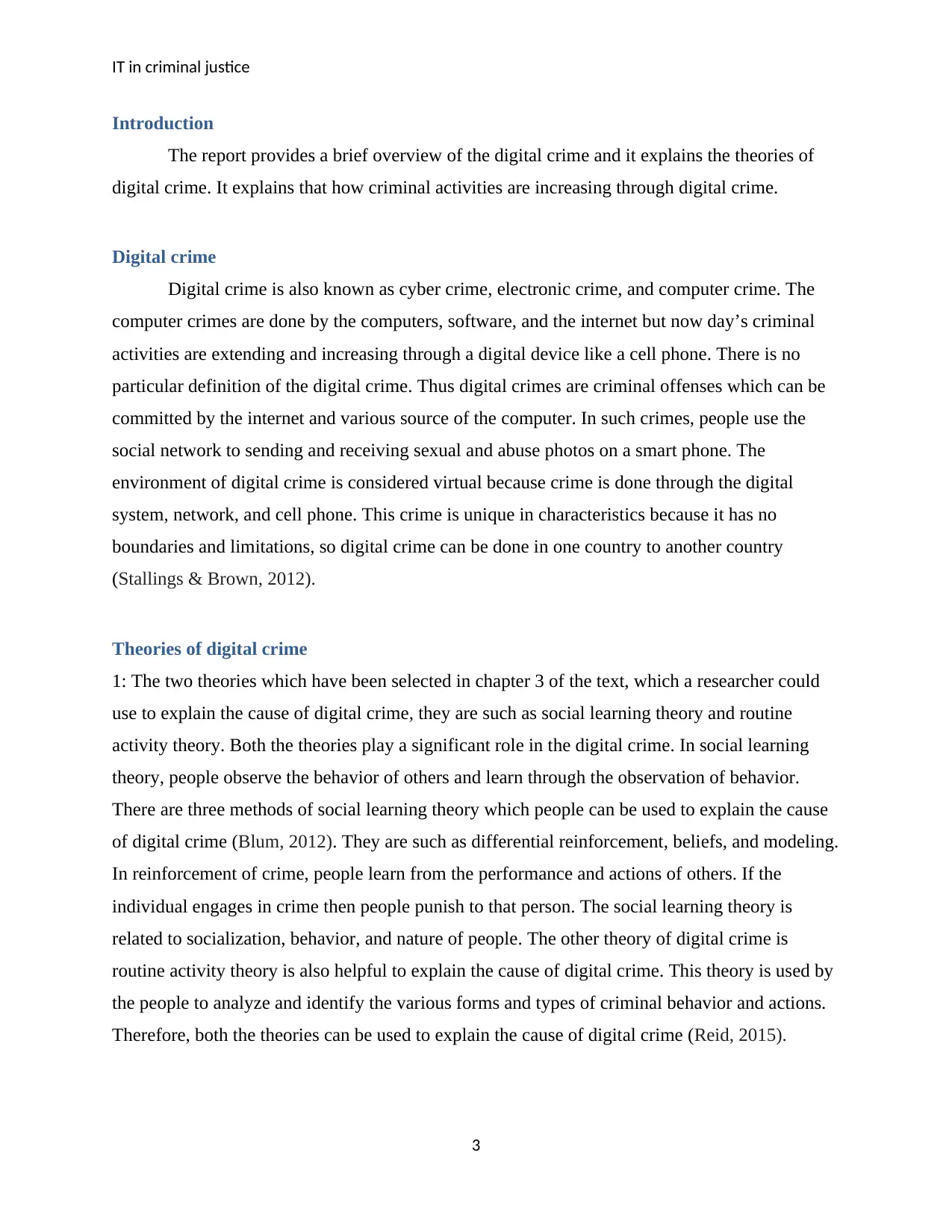
IT in criminal justice
Introduction
The report provides a brief overview of the digital crime and it explains the theories of
digital crime. It explains that how criminal activities are increasing through digital crime.
Digital crime
Digital crime is also known as cyber crime, electronic crime, and computer crime. The
computer crimes are done by the computers, software, and the internet but now day’s criminal
activities are extending and increasing through a digital device like a cell phone. There is no
particular definition of the digital crime. Thus digital crimes are criminal offenses which can be
committed by the internet and various source of the computer. In such crimes, people use the
social network to sending and receiving sexual and abuse photos on a smart phone. The
environment of digital crime is considered virtual because crime is done through the digital
system, network, and cell phone. This crime is unique in characteristics because it has no
boundaries and limitations, so digital crime can be done in one country to another country
(Stallings & Brown, 2012).
Theories of digital crime
1: The two theories which have been selected in chapter 3 of the text, which a researcher could
use to explain the cause of digital crime, they are such as social learning theory and routine
activity theory. Both the theories play a significant role in the digital crime. In social learning
theory, people observe the behavior of others and learn through the observation of behavior.
There are three methods of social learning theory which people can be used to explain the cause
of digital crime (Blum, 2012). They are such as differential reinforcement, beliefs, and modeling.
In reinforcement of crime, people learn from the performance and actions of others. If the
individual engages in crime then people punish to that person. The social learning theory is
related to socialization, behavior, and nature of people. The other theory of digital crime is
routine activity theory is also helpful to explain the cause of digital crime. This theory is used by
the people to analyze and identify the various forms and types of criminal behavior and actions.
Therefore, both the theories can be used to explain the cause of digital crime (Reid, 2015).
3
Introduction
The report provides a brief overview of the digital crime and it explains the theories of
digital crime. It explains that how criminal activities are increasing through digital crime.
Digital crime
Digital crime is also known as cyber crime, electronic crime, and computer crime. The
computer crimes are done by the computers, software, and the internet but now day’s criminal
activities are extending and increasing through a digital device like a cell phone. There is no
particular definition of the digital crime. Thus digital crimes are criminal offenses which can be
committed by the internet and various source of the computer. In such crimes, people use the
social network to sending and receiving sexual and abuse photos on a smart phone. The
environment of digital crime is considered virtual because crime is done through the digital
system, network, and cell phone. This crime is unique in characteristics because it has no
boundaries and limitations, so digital crime can be done in one country to another country
(Stallings & Brown, 2012).
Theories of digital crime
1: The two theories which have been selected in chapter 3 of the text, which a researcher could
use to explain the cause of digital crime, they are such as social learning theory and routine
activity theory. Both the theories play a significant role in the digital crime. In social learning
theory, people observe the behavior of others and learn through the observation of behavior.
There are three methods of social learning theory which people can be used to explain the cause
of digital crime (Blum, 2012). They are such as differential reinforcement, beliefs, and modeling.
In reinforcement of crime, people learn from the performance and actions of others. If the
individual engages in crime then people punish to that person. The social learning theory is
related to socialization, behavior, and nature of people. The other theory of digital crime is
routine activity theory is also helpful to explain the cause of digital crime. This theory is used by
the people to analyze and identify the various forms and types of criminal behavior and actions.
Therefore, both the theories can be used to explain the cause of digital crime (Reid, 2015).
3
⊘ This is a preview!⊘
Do you want full access?
Subscribe today to unlock all pages.

Trusted by 1+ million students worldwide
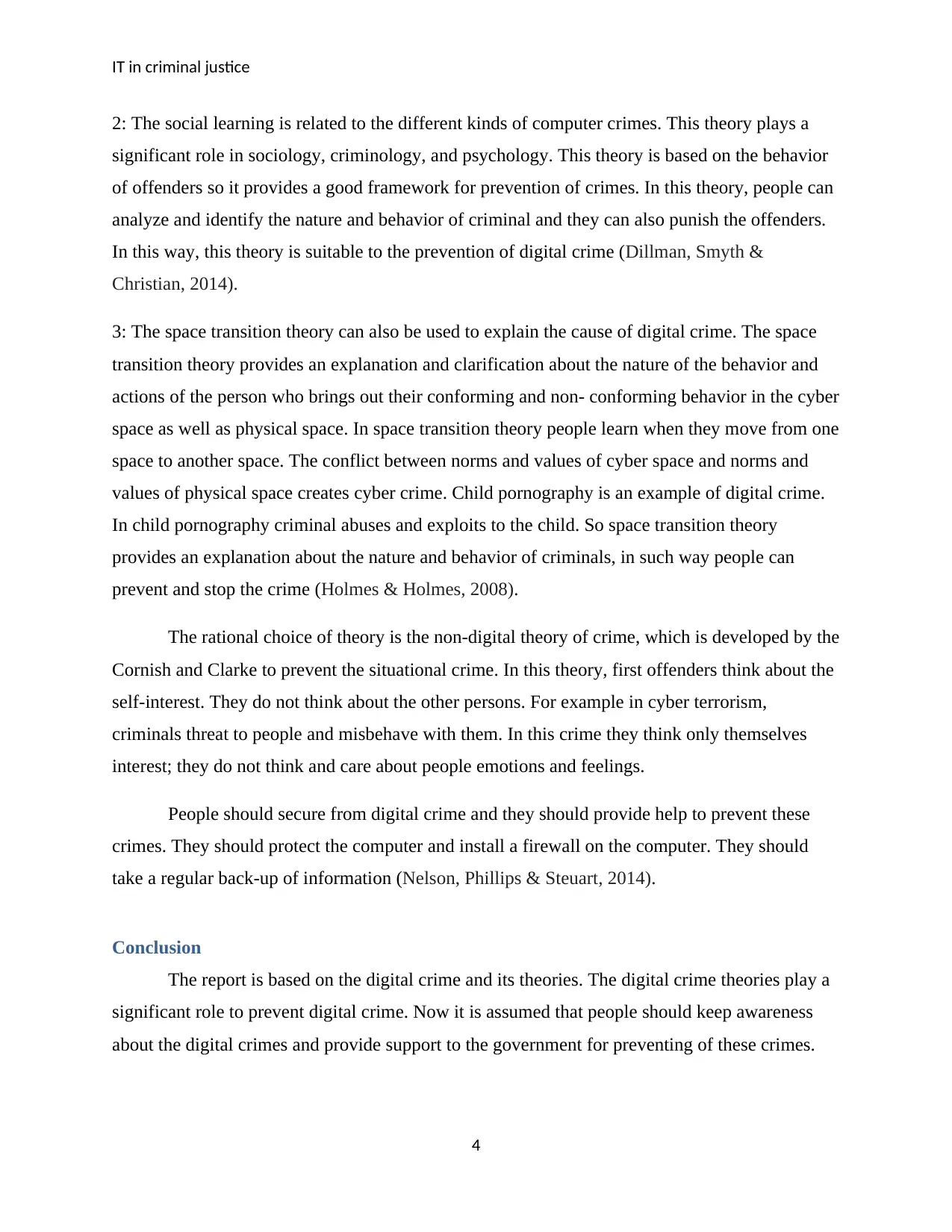
IT in criminal justice
2: The social learning is related to the different kinds of computer crimes. This theory plays a
significant role in sociology, criminology, and psychology. This theory is based on the behavior
of offenders so it provides a good framework for prevention of crimes. In this theory, people can
analyze and identify the nature and behavior of criminal and they can also punish the offenders.
In this way, this theory is suitable to the prevention of digital crime (Dillman, Smyth &
Christian, 2014).
3: The space transition theory can also be used to explain the cause of digital crime. The space
transition theory provides an explanation and clarification about the nature of the behavior and
actions of the person who brings out their conforming and non- conforming behavior in the cyber
space as well as physical space. In space transition theory people learn when they move from one
space to another space. The conflict between norms and values of cyber space and norms and
values of physical space creates cyber crime. Child pornography is an example of digital crime.
In child pornography criminal abuses and exploits to the child. So space transition theory
provides an explanation about the nature and behavior of criminals, in such way people can
prevent and stop the crime (Holmes & Holmes, 2008).
The rational choice of theory is the non-digital theory of crime, which is developed by the
Cornish and Clarke to prevent the situational crime. In this theory, first offenders think about the
self-interest. They do not think about the other persons. For example in cyber terrorism,
criminals threat to people and misbehave with them. In this crime they think only themselves
interest; they do not think and care about people emotions and feelings.
People should secure from digital crime and they should provide help to prevent these
crimes. They should protect the computer and install a firewall on the computer. They should
take a regular back-up of information (Nelson, Phillips & Steuart, 2014).
Conclusion
The report is based on the digital crime and its theories. The digital crime theories play a
significant role to prevent digital crime. Now it is assumed that people should keep awareness
about the digital crimes and provide support to the government for preventing of these crimes.
4
2: The social learning is related to the different kinds of computer crimes. This theory plays a
significant role in sociology, criminology, and psychology. This theory is based on the behavior
of offenders so it provides a good framework for prevention of crimes. In this theory, people can
analyze and identify the nature and behavior of criminal and they can also punish the offenders.
In this way, this theory is suitable to the prevention of digital crime (Dillman, Smyth &
Christian, 2014).
3: The space transition theory can also be used to explain the cause of digital crime. The space
transition theory provides an explanation and clarification about the nature of the behavior and
actions of the person who brings out their conforming and non- conforming behavior in the cyber
space as well as physical space. In space transition theory people learn when they move from one
space to another space. The conflict between norms and values of cyber space and norms and
values of physical space creates cyber crime. Child pornography is an example of digital crime.
In child pornography criminal abuses and exploits to the child. So space transition theory
provides an explanation about the nature and behavior of criminals, in such way people can
prevent and stop the crime (Holmes & Holmes, 2008).
The rational choice of theory is the non-digital theory of crime, which is developed by the
Cornish and Clarke to prevent the situational crime. In this theory, first offenders think about the
self-interest. They do not think about the other persons. For example in cyber terrorism,
criminals threat to people and misbehave with them. In this crime they think only themselves
interest; they do not think and care about people emotions and feelings.
People should secure from digital crime and they should provide help to prevent these
crimes. They should protect the computer and install a firewall on the computer. They should
take a regular back-up of information (Nelson, Phillips & Steuart, 2014).
Conclusion
The report is based on the digital crime and its theories. The digital crime theories play a
significant role to prevent digital crime. Now it is assumed that people should keep awareness
about the digital crimes and provide support to the government for preventing of these crimes.
4
Paraphrase This Document
Need a fresh take? Get an instant paraphrase of this document with our AI Paraphraser
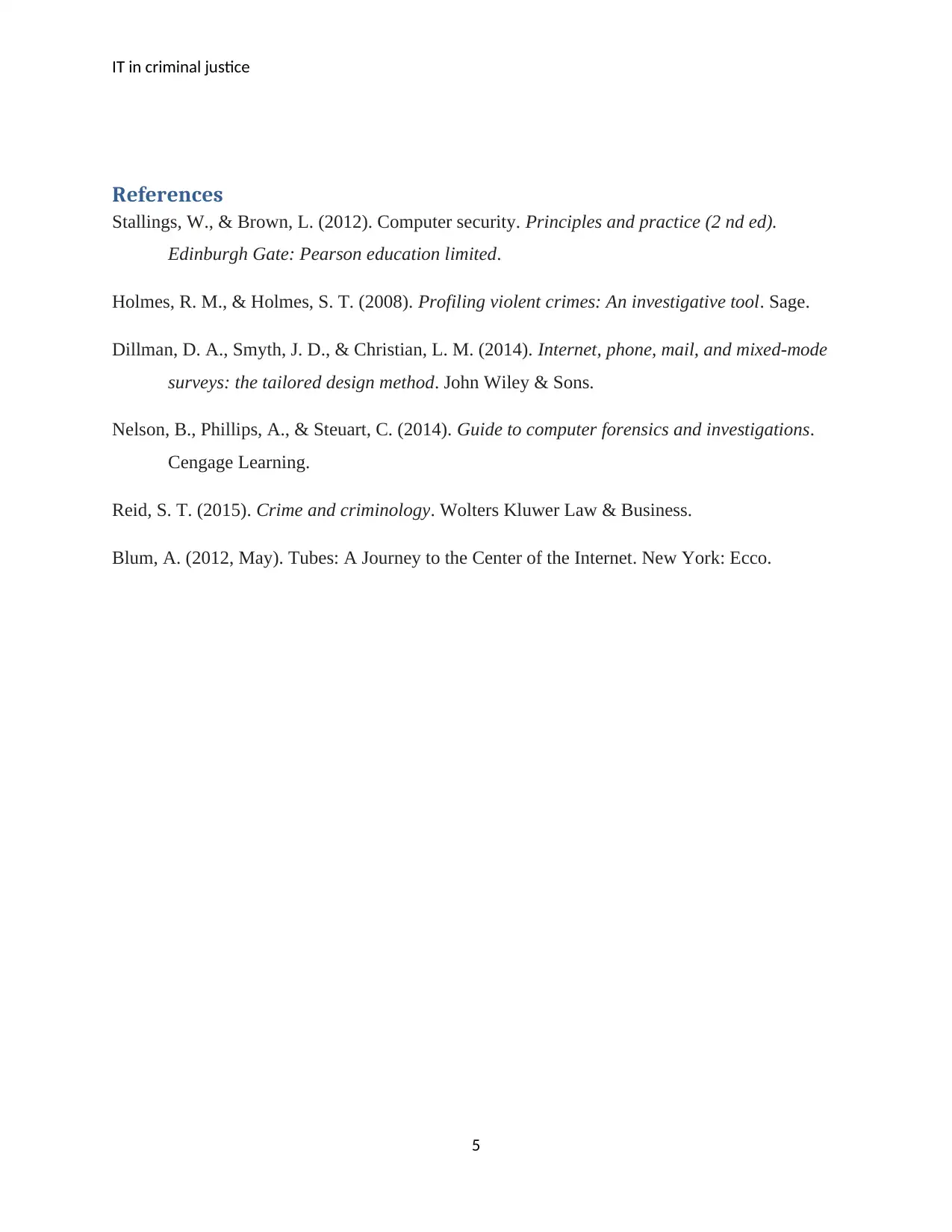
IT in criminal justice
References
Stallings, W., & Brown, L. (2012). Computer security. Principles and practice (2 nd ed).
Edinburgh Gate: Pearson education limited.
Holmes, R. M., & Holmes, S. T. (2008). Profiling violent crimes: An investigative tool. Sage.
Dillman, D. A., Smyth, J. D., & Christian, L. M. (2014). Internet, phone, mail, and mixed-mode
surveys: the tailored design method. John Wiley & Sons.
Nelson, B., Phillips, A., & Steuart, C. (2014). Guide to computer forensics and investigations.
Cengage Learning.
Reid, S. T. (2015). Crime and criminology. Wolters Kluwer Law & Business.
Blum, A. (2012, May). Tubes: A Journey to the Center of the Internet. New York: Ecco.
5
References
Stallings, W., & Brown, L. (2012). Computer security. Principles and practice (2 nd ed).
Edinburgh Gate: Pearson education limited.
Holmes, R. M., & Holmes, S. T. (2008). Profiling violent crimes: An investigative tool. Sage.
Dillman, D. A., Smyth, J. D., & Christian, L. M. (2014). Internet, phone, mail, and mixed-mode
surveys: the tailored design method. John Wiley & Sons.
Nelson, B., Phillips, A., & Steuart, C. (2014). Guide to computer forensics and investigations.
Cengage Learning.
Reid, S. T. (2015). Crime and criminology. Wolters Kluwer Law & Business.
Blum, A. (2012, May). Tubes: A Journey to the Center of the Internet. New York: Ecco.
5
1 out of 5
Related Documents
Your All-in-One AI-Powered Toolkit for Academic Success.
+13062052269
info@desklib.com
Available 24*7 on WhatsApp / Email
![[object Object]](/_next/static/media/star-bottom.7253800d.svg)
Unlock your academic potential
Copyright © 2020–2025 A2Z Services. All Rights Reserved. Developed and managed by ZUCOL.




